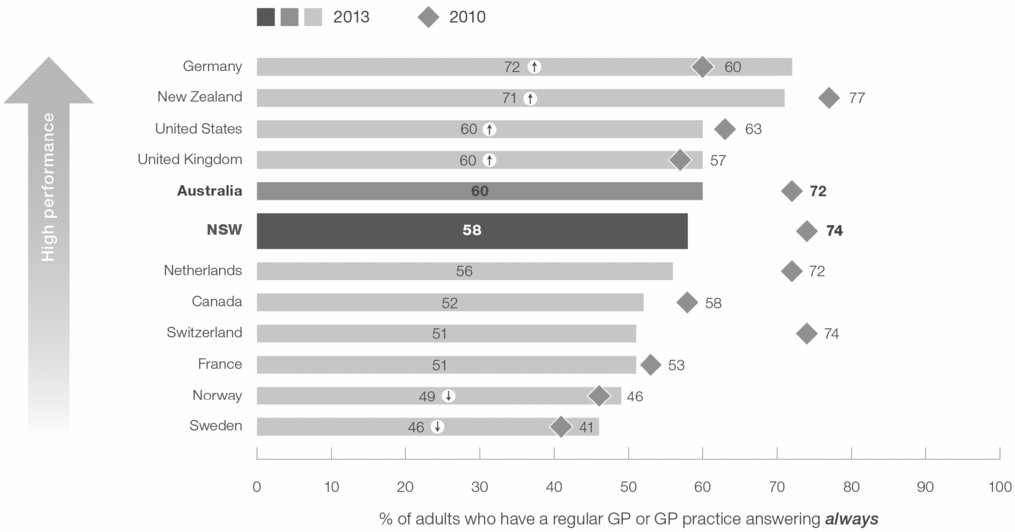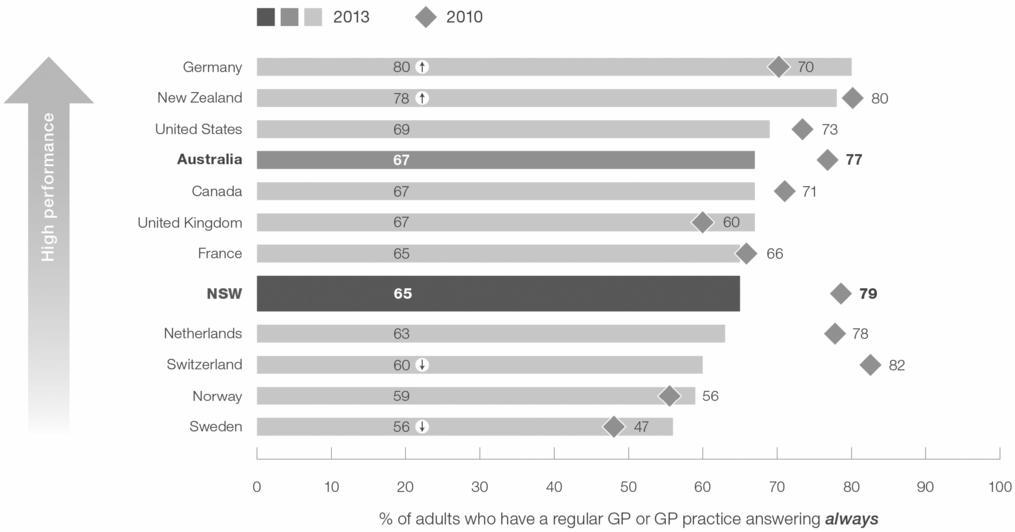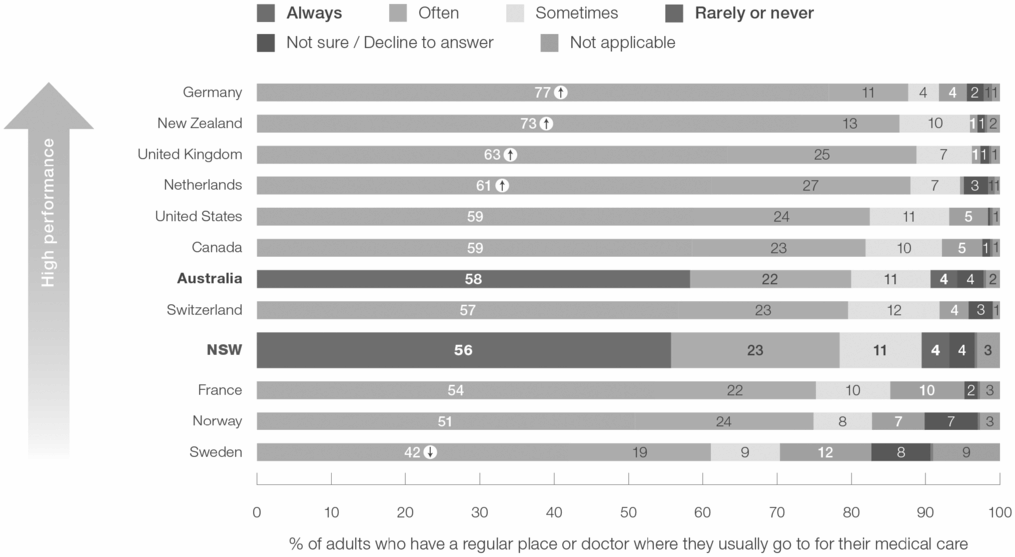- patient-centred
putting the needs of the patient at the centre of processes and priorities.
Problems in healthcare communication
Only about 50% of patients recently surveyed by the Commonwealth Fund in the US feel that their doctor spends enough time with them. Consider Figure 1.1, which is taken from a recent Bureau of Health Information (New South Wales) report. The figure shows the approval rating of how long Australian medical staff spend with their patients (60%) to be level with UK and US ratings:

Figure 1.1 Commonwealth Fund survey 2010 and 2013 When you need care or treatment, how often does the regular doctor/GP or medical staff you see spend enough time with you? (BHI, 2014)
Of interest here is that the 2013 approval rating of Australian and New South Wales medical clinicians is considerably lower than its 2010 equivalent. Does this mean patients are becoming more demanding? Or are doctors becoming busier?
Now consider Figure 1.2. This figure shows that a slightly greater percentage of patients (67% in 2013) find their doctor easy to understand. But this percentage too is down from 77% in 2010.

Figure 1.2 Commonwealth Fund survey 2010 and 2013 When you need care or treatment, how often does the regular doctor/GP or medical staff explain things in a way that is easy to understand? (% answering always) (BHI, 2014)
Why is this so? Does the lower 2013 percentage result from rising patient expectations? Or is it because more patients and practitioners have arrived from overseas, needing to work harder on clear explanations? And what might explain patients’ view that only in about 53% of cases their provider ‘always knows’ their medical history (Figure 1.3)? Could this be an effect of greater ‘patient mobility’ – do patients move house, state and country more often? Could it also result from the growing amounts of information that practitioners need to gather and process? And what might be the effect of the rising complexity of patients’ diseases, now that more people are chronically ill, and also more often now have multiple diseases, or ‘co-morbidities’?

Figure 1.3 Commonwealth Fund survey 2013 When you need care or treatment, how often does the regular doctor/GP or medical staff you see know information about your medical history? (BHI, 2014)
When we look at health care from the perspective of what patients complain about, we also note that shortcomings in communication are high on the list (Robins, Fasih & Schweitzer, 2014). A review of 59 studies reporting on a total of 88 069 patient complaints found that one of the two primary factors underlying complaints was communication (the other being treatment problems (Reader, Gillespie & Roberts, 2014)). For patients generally, good, open and honest communication has been found to be a critical component of effective care (Iedema et al., 2011).
- complaints
a person’s expressions of dissatisfaction with care services received.
We can also look at healthcare communication from the perspective of healthcare incidents, or care gone wrong (see Chapter 22). Here it becomes even more apparent that inadequate communication creates high levels of dissatisfaction and tension (Sutcliffe, Lewton & Rosenthal, 2004).
Furthermore, a number of studies have now shown that inadequate communication itself may cause communication failures, and that these failures have real consequences for patients’ health: they harm patients (Iedema et al., 2008). Much of this communication harm has been shown to be avoidable. For example, more effective ward round and clinical handover communication contributes to avoiding communication failures. A study of Danish incident reports revealed that 52% of the incidents identified in a review of 84 error investigation reports were caused by ‘avoidable communication problems’ (Rabøl et al., 2011). This finding that inadequate communication or non-communication is a prominent cause of patient harm in health services, particularly for patients from linguistically and culturally diverse backgrounds, is now a common one (Gu, Itoh & Suzuki, 2014; Siu, Maran & Paterson-Brown, 2014).
For patients who come into care with communication challenges due to mental health issues, speech disability, dementia or delirium, the situation is markedly worse still. They have a 46% higher chance of experiencing a clinical error (Bartlett et al., 2008). We address each of these challenges in the chapters that follow.
Improving healthcare communication
The Commonwealth Fund and New South Wales Bureau of Health Information data presented above were derived from surveys asking patients for feedback. In the not-so-distant past, these kinds of feedback were rarely sought from patients. Patient feedback surveys have become prominent only in the last decade or so (Jenkinson, Coulter & Bruster, 2002). Patients’ views on their care and on how practitioners communicate with them are considered increasingly important (Weissman et al., 2008). Regular patient satisfaction surveys are now done across Western industrialised countries, a trend that was started by the Picker Institute in the UK (Jenkinson, Coulter & Bruster, 2002). Many government agencies now use ‘patient trackers’ or on-the-spot feedback surveys using electronic tablets which communicate with a central database that can process thousands of surveys at a time.
But understanding how patients are experiencing care is only one side of the coin. The other side of the coin is how we address the communication shortcomings that patients help us identify. In recent years, a range of strategies has emerged for ensuring that clinician–patient communication improves. One is ‘informed consent’ (Chapter 14). Informed consent ensures that clinicians ask patients for permission before they initiate treatments. Likewise, shared decision-making is a strategy that calls attention to the importance of clinicians sharing decisions with patients, rather than imposing decisions on them (Chapter 12). A much more recent initiative is ‘open disclosure’, a policy that requires clinicians to be open and honest about mishaps in care (Chapter 22).
- shared decision-making
decision-making in which patients and clinicians make treatment plans and decisions together. Shared decision-making discussions take account of best scientific evidence available, as well as patient’s values and preferences.
The reason communication is now considered so important is not just that patients are becoming more assertive about their rights, less tolerant of problematic service standards, and more vocal in their criticism of inadequate health care. Better communication is needed not just to satisfy patients’ ‘service expectations’ but is also critical to delivering good care, to minimising avoidable readmissions, and to maximising patients’ ability to manage their own care.
The centrality of communication to care is due to the rising complexity of care: more aspects of care need to be negotiated ‘on the spot’. Complexity means this: events have many different dimensions, events are less easily categorised and acted on than they were before, and more communication is now necessary to determine what to do next, even if sometimes events can pose ‘wicked problems’. Wicked problems are problems where there is no easy solution. In these circumstances, stakeholders need to be given the opportunity to come to terms with the ‘size’ of the problem, with the potential lack of a solution altogether, and with the kind of compromise solution that may need to be adopted. The ‘wicked problem’ described in practice example 1.1 exemplifies what we mean.
While still living at home, a 78-year-old female patient is under palliative care treatment at an Australian teaching hospital. Last week, she needed to go into hospital as her lungs have been filling with fluid and she was finding it difficult to breathe. This was her second visit to the hospital in two weeks. This is how she talks about what happened: ‘My palliative care doctor happened to be away last week, [since he was] having a minor operation, so no one really “owned” me when I arrived on the Tuesday.’ I identified that she felt like a medical orphan.
For an unknown reason, possibly as a consequence of her own doctor being away, the hospital staff took three days to determine that a drain should be inserted in one of her lungs instead of just draining it. The drain would help solve her breathing problem, and would mean that she didn’t need to keep coming back for treatment. Before the procedure on the Friday morning, she was ‘nil by mouth’ (fasting). At about 10:30 a.m., they took her down to surgery, prepped her, covered her with green sheets and placed her lying on her side. This meant she was lying on the leg which had the tumour that was in fact the cause of her impending death, and the pain it caused had been treated with morphine for quite some time. She was left lying on the tumour for an hour. She was in agony, she said. No one was aware of her agony, and no one explained to her what was happening.
Then, suddenly, there was a mad flurry and someone came to tell her that ‘they couldn’t find a drain’. It seemed that the person whose job it was to check ‘the equipment’ in question had not done so.
Next, a number of senior doctors came and spoke to her and ‘explained’ how they were getting in touch with the drain supplier. They expressed regret, but did not apologise to her. They explained the mishap again, and they also said that ‘they themselves were very shaken by the whole experience’. After that, a nurse dressed her and returned her to her room.
Then at 4 p.m., she was once again wheeled down to surgery. Once there, she was left waiting for another hour, during which time no one communicated with her about what was going on. Eventually, at 5 p.m., she was given another anaesthetic and the operation commenced. The surgeons and anaesthetists had decided to give her not a local but a general anaesthetic, due to the patient’s now highly stressful state. The drain insertion operation went well.
The patient had been nil by mouth since that Friday morning, and, following the surgery, she was not given dinner. The following morning, the Saturday, she was not given breakfast. She had now gone without food for more than 24 hours. Only after she created a fuss requesting some food was she brought something to eat.
Stay updated, free articles. Join our Telegram channel

Full access? Get Clinical Tree


